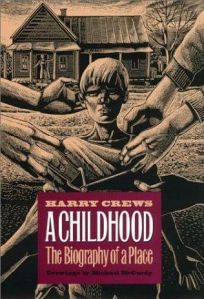I showed the above clip of Harry Crews telling stories from the 2003 film Searching for the Wrong Eyed Jesus to my class at the beginning of this final unit on narrative analysis. The clip is a great introduction to the unit, showing quite directly how we use stories to understand the world we live in. The class responded pretty well to it, and I decided to use a selection from Crews’s memoir, A Childhood: the Biography of a Place, to discuss the elements of non-fiction narratives.
 On the day that they were to have read the Crews selection, I separated them in to 4 groups and gave each group a theme to discuss together and then share as a group. (The themes in question were: storytelling, gender, difference and race, and class.) The responses I received from this analysis was underwhelming. While most of the students said they enjoyed reading Crews, they seemed less than thrilled to have to dig deeper in the piece and think about these ideas. But, more than that, I think the group dynamic caused more distraction than constructive thought.
On the day that they were to have read the Crews selection, I separated them in to 4 groups and gave each group a theme to discuss together and then share as a group. (The themes in question were: storytelling, gender, difference and race, and class.) The responses I received from this analysis was underwhelming. While most of the students said they enjoyed reading Crews, they seemed less than thrilled to have to dig deeper in the piece and think about these ideas. But, more than that, I think the group dynamic caused more distraction than constructive thought.
My classroom is not very large, and I can hear every conversation that goes on from any spot in the room. I heard more conversation about what students did over the weekend than conversations about thematic elements of the reading. When they shared their thoughts, the examinations were hardly more than surface level; students simply pulled out examples of the themes in the reading, exact quotes, and offered little or no evaluative thought concerning these examples. I spent the remainder of the class trying to push them further in their thinking, but they just weren’t biting.
So, for their reading the following class period, I tried a different approach. I gave them a story, “The Fights,” from Donald Ray Pollock‘s collection titled Knockemstiff. I offered them nothing ahead of time concerning how to read the story or what to think while reading. I simply gave them the task of reading.
When class began on Wednesday, I first asked whether or not they like the story, to which some responded positively, and others said they were confused, that nothing happened and they didn’t understand why they were reading it. When I got a few personal responses, I told the students to take out a piece of paper and they had the next 15 minutes to complete a shortwrite in which they would write freely about the cultural and ethical elements of the story by examining the characters, setting, plot, and theme. They wrote diligently and we spent the remainder of the class discussing what they had written and what exactly was going on in the story. I got a number of excellent responses from this exercise and a few students showed a true understanding of what this type of analysis can do for a reading. I think that even a few of the students confused as to why we were reading the story were won over to the complexities of Pollock’s work by the end of the class.
In the course of this project, Christine and I have read a number of pieces that showed the benefits of group work to students. Participants in our student survey remarked about the benefits of group work in their classes. So I remain a bit baffled when I think about the differing levels of productivity demonstrated by the two activities described above.
The group work activity with the Harry Crews reading was less than fruitful. Often times, it proved to be a bumbling mess. Meanwhile, the quite, individualized activity with the Pollock story offered a much stronger response and level of thought, resulting in a stimulating full-class discussion.
I wonder is the timing of the readings had an effect on the students’ receptions of the activities. Were they less enthralled with the Crews activity because it was a Monday and the lethargy of the weekend had yet to wear off? Because the Crews selection was to be done over a weekend, did less students read it, and is that why the responses were weak? Did they not like being given the themes they were to discuss? Or do the group discussion really act as a distraction, offering the students a chance to socialize when they think the teacher isn’t listening?
I don’t honestly have an answer to any of these questions, but thanks to the results of these two exercises, I am more apt to do individualized activities when it concerns reading like this in the future.
If anyone reading this has some suggestions or responses to these answers, I would love to hear from you in the comments section. It could be a great conversation to get started.
-Eric


